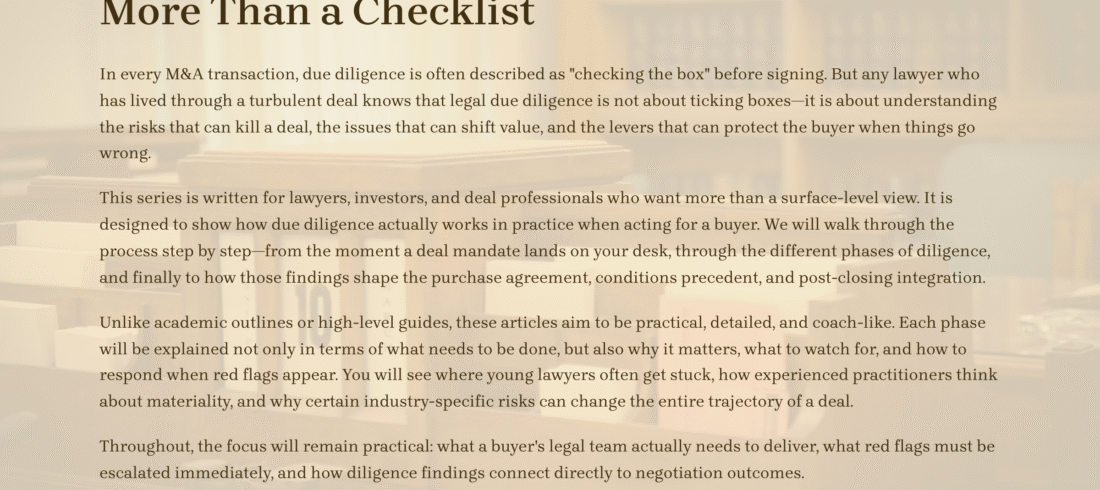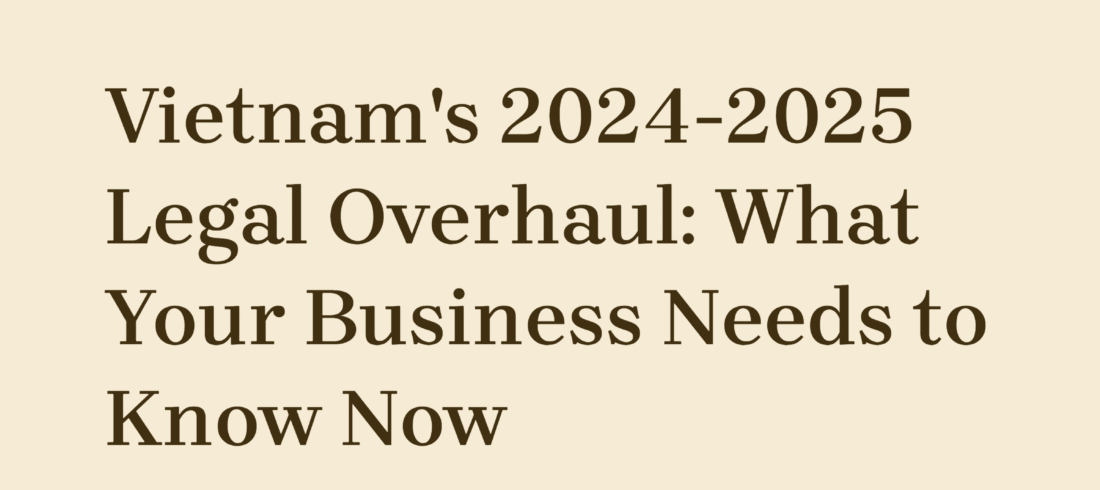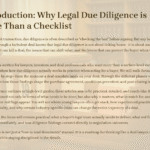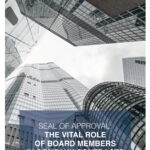To read or download the article, please click the following link.
Phase 1: Scoping with the Client in Legal Due Diligence
(Part of the Buyer-Side Legal DD Series)
When a buyer instructs you to run legal due diligence on a potential acquisition, your first instinct may be to jump straight into the data room and start reviewing contracts. Resist that urge. Phase 1: scoping with the client, is where you set the stage. This phase determines whether your diligence will be a strategic exercise that supports decision-making, or a box-ticking scramble that leaves value on the table.
Think of Phase 1 as a coaching session with the client. You’re not only asking questions; you’re listening for what matters most, testing assumptions, and translating business goals into legal workstreams. The more disciplined you are here, the sharper and faster your entire review will be.
Start Informed: The Pre-Read
Before speaking with the client, you should already understand the basics of the deal. Collect the teaser, CIM, LOI or term sheet, management presentation, and if possible, the buyer’s financial model. Skim registry extracts, IP databases, and litigation dockets for anything public. With that, prepare a one-page briefing note: what the target does, where it makes money, what looks like a “crown jewel,” and where obvious risks may hide. This way, your scoping call begins with insight, not ignorance.
The Scoping Call: Asking the Right Questions
The scoping call with the client is not just about gathering information; it is about framing the diligence as a strategic tool. Walk the client through clear themes:
- Deal perimeter & structure: What exactly is being acquired: shares, assets, or a carved-out business? Which geographies are in play, and what’s excluded?
- Business model & economics: Where does revenue come from? Who are the top customers and suppliers? What drives margins?
- Crown jewels: Ask bluntly: “What could kill this deal if we can’t transfer it?” Often the answer is licenses, source code, data sets, land banks, or a handful of key contracts. Write these down word for word. They become your “always material” list.
- Regulatory exposure: Does the business run on sectoral licenses? Are approvals tied to individuals? Any merger control or foreign investment concerns?
- Technology & data: How dependent is the business on software, IP, or personal data? Is open-source code part of its products? Has it suffered breaches?
- People & culture: Who are the key employees? Are there unions or works councils that could delay a transfer? What change-in-control triggers might detonate bonuses?
- Real estate & environment: Which sites are critical? Any contamination notices or lease restrictions?
- Litigation & compliance: Are there injunctions, government investigations, or consent decrees?
- Integration intent: What must be operational on Day 1: billing, payroll, branding? How does the buyer want to use data post-close?
- Risk appetite: Which risks are acceptable with escrows or insurance, and which are walk-aways?
Run this call like a coach: short, clear questions, live note-taking, and constant steering back to the buyer’s thesis.
Translating the Thesis into Diligence Objectives
After the call, convert what you heard into 8–15 Thesis Questions: plain-English challenges your diligence must answer. For example:
- “Can customer data lawfully be repurposed for cross-selling within 90 days post-close?”
- “Are the top five customers locked in beyond one year, or can they walk at will?”
For each Thesis Question, assign a workstream owner, note the evidence you need, and identify the eventual SPA hook: representation, covenant, condition precedent, or indemnity. This ensures every hour of DD is tied back to deal value.
Crafting the R1 Request List
Your first request to the seller, the R1 list, should be surgical, not bloated. It focuses on red-flag issues that link directly to the crown jewels and thesis questions. For example:
- Corporate documents: charters, shareholder agreements, cap table.
- Contracts: top customers and suppliers, plus any with change-of-control or exclusivity.
- IP: registrations, founder assignments, open-source policy and scans.
- Privacy & cyber: data inventory, breach logs, vendor list, certifications.
- Regulatory licenses: current status and expiry.
- Employment: roster, key-person contracts, union agreements.
- Real estate: title deeds, major leases, environmental notices.
- Litigation: pleadings, settlements, government inquiries.
Keep it to 60 – 120 items. If a request doesn’t connect to a thesis question, cut it.
Materiality and Sampling
Phase 0 gave you generic thresholds, but now you must calibrate them to this deal. Set quantitative cut-offs (e.g., contracts above 1% of revenue), and a qualitative “always material” list (e.g., anything involving the crown jewels). Define sampling rules, review the top 20 contracts by value, a random 10, and all with change-of-control clauses. Record this in a one-page Materiality Addendum and have the client sign off. This prevents over-lawyering on trivial items or, worse, missing a small contract with a big risk.
Building the Risk → Lever Matrix
Every anticipated risk should have a default playbook response:
- Price adjustment for financial exposure.
- Special indemnity for discrete but serious risks (e.g., IP ownership, environmental).
- Escrow or holdback for contingent liabilities.
- Covenant or CP for consents and regulatory approvals.
- Earn-out where risk and upside can be shared.
- R&W insurance when speed matters or seller pushes back.
This “Risk → Lever Matrix” becomes the bridge between diligence findings and negotiation strategy.
Mapping Jurisdictions and Local Counsel
Do not underestimate geography. Build a map of where the target operates, sells, stores data, employs people, owns land, or holds licenses. For each jurisdiction, flag merger control, FDI reviews, and sectoral licenses. Engage local counsel early, with clear scopes (employee transfer rules, license transferability, land title checks). This avoids surprises like a foreign ownership cap discovered at the eleventh hour.
Stakeholder Access Plan
Some answers don’t live in documents. You need management Q&A sessions, reference calls with customers or suppliers, and sometimes site visits. Schedule them early. Always send question lists in advance, keep lawyers on the line, and avoid triggering change-of-control or consent provisions. Sensitive information should be routed through a clean team if the buyer is a competitor.
Quick Public-Source Checks
Even before the data room opens, you can learn a lot. Run registry searches for liens or pledges, IP lookups for oppositions or gaps, court dockets for litigation patterns, and sanctions/PEP screens for key names. These “day zero” checks often confirm, or contradict, what management has told the buyer.
Exit Criteria for Phase 1
Do not move forward until you have:
- Agreed Thesis Questions (8–15, with owners and SPA hooks).
- Drafted the Risk → Lever Matrix.
- Issued the R1 Request List and set the Q&A protocol.
- Finalized the Materiality Addendum.
- Built the Jurisdiction Map with local counsel identified.
- Scheduled stakeholder access.
- Logged public-source findings.
- Circulated an updated Issue Register.
Coaching the Juniors
Finally, remember what I tell my team:
- Anchor every request to the deal thesis.
- Ask for evidence, not just explanations.
- Escalate issues with solutions, not just problems.
- Write precisely: counterparties, dates, values.
- Protect the process: use the Q&A protocol, respect clean team rules, and avoid triggering consents.
Phase 1 is not document review, it is deal design. Done well, it sharpens focus, reduces wasted hours, and positions you to turn diligence findings into real negotiating leverage. Done poorly, you drown in PDFs and miss the issues that matter. Treat it as coaching the client—and coaching your own team—toward clarity of purpose.







